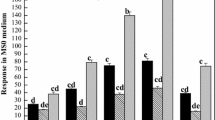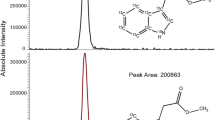Abstract
The metabolism of exogenously applied14C-24-epibrassinolide (14C-EBR) in seedlings of cucumber and wheat was examined. Total lipids were extracted with isopropanol and chloroform, and then partitioned with water. More than 80% of radioactivity was distributed to chloroform-phase. Concentrated chloroform-phase was applied to silica gel plate and was developed with chloroform-ethanol (5:1 v/v). Rf value of original14C-EBR was about 0.6. In cucumber leaves harvested after 2 day-culture, three peaks were detected at Rf 0.11, 0.47 and 0.84. In cucumber petioles of 2 day-culture, however, a major peak was detected at Rf 0.90. But14C-EBR was hardly metabolized in hypocotyls and roots after 2 days.
In wheat leaves harvested just after pulse labeling, a peak was detected at Rf 0.63. By further analysis of this peak using ODS-HPLC, however, an original peak of14C-EBR and two metabolites having higher polarity were detected. In wheat leaves harvested after 2 day-culture, the profile of TLC scanning was similar to that just after pulse labeling, although, an original peak of14C-EBR was no longer detected by ODS-HPLC. In wheat roots,14C-EBR was hardly metabolized. These results indicate that14C-EBR occurring in leaves and petioles is metabolized to produce several kinds of metabolites.
Similar content being viewed by others
Abbreviations
- EBR:
-
24-epibrassinolide
- BR:
-
brassinosteroid
- MPLC:
-
high-performance liquid chromatography
- TLC:
-
thin layer chromatography
References
Gamoh, K., Omote, K., Okamoto, N. andTakatsuto, S. 1989. High-performance liquid chromatography of brassinosteroids in plants with derivatization using 9-phenanthreneboronic acid. J. Chromatography469: 424–428.
Kates, M. andEberhardt, F.M. 1957. Isolation and fractionation of leaf phosphatides. Can J. Botany35: 895–905.
Kim, S. 1991. Natural occurrences of brassinosteroids.In H. G. Cutler, T. Yokota, and A. Gunter, eds., Brassinosteroids: Chemistry, Bioactivity, and Applications, ACS symposium series474: pp. 26–35.
Kimura, J. (1931). On the behavior of rice to mineral nutrient in solution-culture, especially compared with those of barley and wheat (in Japanese). J. Imp. Agr. Exp. Sta.1: 375–402.
Kolbe, A., Schneider, B., Porzel, A., Voigt, B., Krauss, G. andAdam, G. 1994. Pregnane-type metabolites of brassinosteroids in cell suspension cultures of Ornithopus sativus. Phytochemistry36: 671–673.
Nishikawa, N., Toyama, S., Shida, A. andFutatsuya, F. 1994. The uptake and the transport of14C-labeled epibrassinolide in intact seedlings of cucumber and wheat. J. Plant Res.107: 125–130.
Sakurai, A. andFujioka, S. 1993. The current status of physiology and biochemistry of brassinosteroids. Plant Growth Regul.13: 147–159.
Sasse, J.M. 1991. The case for brassinosteroid as endogenous plant hormones.In H. G. Cutler, T. Yokota, and A. Gunter, eds., Brassinosteroids: Chemistry, Bioactivity, and Applications, ACS symposium series474: pp. 58–166.
Schlagnhaufer, C.D. andArteca R.N. 1991. The uptake and metabolism of brassinosteroid by tomato (Lycopersicon esculentum) plants. J. Plant Physiol.138: 191–194.
Schneider, B., Kolbe, A., Porzel, A. andAdam, G. 1994. A metabolite of 24-epi-brassinolide in cell suspenssion cultures ofLycopersicon esculentum. Phytochemistry36: 319–321.
Yokota, T., Ogino, Y., Takahashi, N., Saimoto, H., Fujioka, S. andSakurai, A. 1990. Brassinolide is biosynthesized from castasterone inCatharanthus roseus crown gall cells. Agric. Biol. Chem.54: 1107–1108
Yokota, T., Ogino, Y., Suzuki, H., Takahashi, N., saimoto, H., Fujioka, S. and Sakurai, A. 1991. Metabolism and biosynthesis of brassinosteroids.In H. G. Cutler, T. Yokota, and A. Gunter, eds., Brassinosteroids: Chem-istry, Bioactivity, and Applications, ACS symposium series474: pp. 86–96.
Yokota, T., Higuchi, K., Kosaka, Y. andTakahashi, N. 1992. Transport and metabolism of brassinosteroids in rice.In C.M. Karssen, L.C. van Loon, and D. Vreugdenhil, eds., in Progress in Plant Growth Regulation, Kluwer Academic Publishers, Dordrecht, pp. 298–305.
Author information
Authors and Affiliations
Rights and permissions
About this article
Cite this article
Nishikawa, N., Shida, A. & Toyama, S. Metabolism of14C-labeled epibrassinolide in intact seedlings of cucumber and wheat. J. Plant Res. 108, 65–69 (1995). https://doi.org/10.1007/BF02344307
Received:
Accepted:
Issue Date:
DOI: https://doi.org/10.1007/BF02344307




